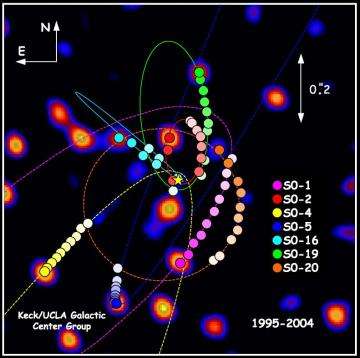Astronomers Provide New Insights Into Massive Black Hole Surroundings at Center of the Milky Way

UCLA astronomers can determine, for the first time, orbits of massive young stars located a few light months from the enormous black hole at the center of our Milky Way galaxy — stars that hold an imprint of how they were born.
The origin of young stars at the center of our galaxy has puzzled astronomers, but the orbits may be the key to unlocking the mystery, UCLA astronomy graduate student Jessica Lu reported today at the annual meeting of the American Astronomical Society in Washington, D.C. The astronomers use a new laser virtual star at the W.M. Keck observatory in Hawaii.
The hostile environment around the supermassive black hole should make it extremely difficult for stars to form, but many young stars have been detected around the black hole, said Lu, who reported that she and a UCLA team are tracking a puzzling group of more than 30 massive young stars of uncertain origins.
"How were these stars formed in such an inhospitable region?" Lu asked. "My advisor, Andrea Ghez, calls this mystery 'the paradox of youth.' Using the Keck's Laser Guide Star adaptive optics system, we expect to resolve the paradox. We are able to measure how these young stars move across the sky with an unparalleled precision (only two kilometers per second) and determine, for the first time, the orbit of each of the young stars located a few light months from the black hole.
"Just as a fingerprint can be used to identify a person, the information encoded in the orbits of the young stars will tell us how and where they formed," said Lu, a member of a UCLA research team including her advisor, Ghez, a UCLA professor of physics and astronomy.
Lu added that these are the closest stars to the supermassive black hole that have not had their orbits distorted by their inhospitable environment.
"The orbits of these young stars suggest the stars were born far from the black hole in a massive star cluster, which migrated in," Lu reported. "We can now track the stars so precisely as they move around the black hole that we can determine each star's exact orbit."
The research was conducted using the 10-meter Keck II Telescope, which is the world's first 10-meter telescope with a laser on it. Laser Guide Star allows astronomers to "generate an artificial bright star" exactly where they want it, which reveals the atmosphere's distortions.
Black holes are collapsed stars so dense that nothing can escape their gravitational pull, not even light. Black holes cannot be seen directly, but their influence on nearby stars is visible, and provides a signature, Ghez said.
The supermassive black hole, with a mass more than 3 million times that of our sun, is in the constellation of Sagittarius. The galactic center is located due south in the summer sky.
Co-authors on the research include fellow UCLA graduate student Seth Hornstein; the adaptive optics team at W. M. Keck Observatory: David Le Mignant, Marcos Van Dam and Peter Wizinowich; Antonin Bouchez (formerly with the W. M. Keck Observatory) and Keith Matthews at Caltech; Mark Morris, a UCLA professor of physics and astronomy; and Eric Becklin, a UCLA professor of physics and astronomy.
Source: UCLA















